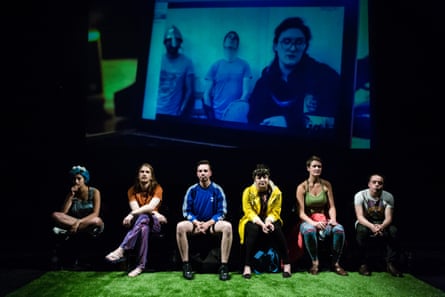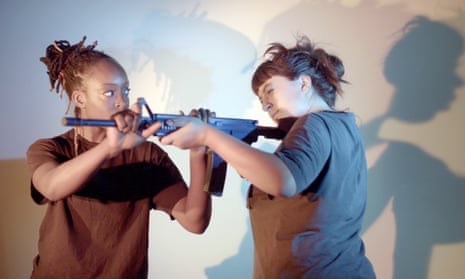In a windowless room in a disused office block, Breach Theatre are rehearsing a terrorist attack. Three actors take turns to brandish a rubbery, banana-yellow handgun. They are, almost immediately, taken down with flying rugby tackles that send them crashing into a school gym mat. Thwack! Another shooter hits the deck. Thwack, thwack, thwack. It goes on for an hour.
The point is that practice makes perfect – in theatre as in emergency situations. We rehearse for both, and “lockdown” drills preparing children for the threat of active shooters are on the rise in American schools. Breach’s new show, The Drill, questions the effectiveness of such procedures. It asks whether playing out attacks increases rather than diminishes their potency.
It’s a typically intriguing proposition from one of the country’s brightest young theatre companies. A collaboration between three Warwick University graduates – Billy Barrett, Ellice Stevens and Dorothy Allen-Pickard – Breach are on to their third show in less than three years. For an emerging company, they have an exceptionally distinctive, fully-fledged voice. “We’re just making shows,” says Barrett. “It’s just that each show has built on the one we did before.”
Breach’s debut, The Beanfield, was a fragmented account of seven students’ doomed attempt to re-enact the Battle of the Beanfield between peace campers and Warwickshire police 30 years on. Their approach stitched together video and live performance, dialogue and dance, fact and fiction, past and present.
It was the sort of Edinburgh fringe hit no one sees coming: a student company, playing at 10am in a hotel conference room. “The first week felt like a real slog,” says Stevens. “There were about three people at each show and, because it was so early, at least one of them would be asleep.” By the end of the month, they were Total Theatre award-winners with a sellout show.
Their follow-up, Tank, took an even less likely starting point – scientists’ attempts to communicate with dolphins using LSD in the 1960s. (“All of our shows begin with a Guardian article,” Barrett jokes.) Using real-life transcripts, Tank twisted verbatim theatre techniques into knots. How, after all, do you accurately represent dolphin “speech” on stage? The conversation between species became a proxy for cross-cultural exchange.

You could call Breach’s work documentary theatre – but it always acknowledges its inherent unreliability. All this, they say, may or may not be true and rather than simply recounting facts, Breach place themselves into the story – an attempt, Barrett says, “to get rid of any sense of objectivity”.
Their patchwork style keeps audiences on their toes. Since, as Stevens says, “the rules keep shifting”, we have to constantly reassess how to watch and judge for ourselves where the truth stops and theatre steps in. “In telling stories about the past, you’re always constructing the present,” says Barrett. “You’re telling a story about yourselves now. Re-enactment is this ritualistic process of trying to bring something back, but what you’re doing is telling a new story.”
The Drill turns that on its head. Rather than bringing the past into the present, these enacted emergencies try to pre-empt the future. They’re just as ritualistic: by playing out the worst, we are trying to prevent it.
For the last year, Breach have been putting themselves through such exercises. They’ve taken first aid courses and trained to evade shooters and identify explosive devices. The leader of one training course they attended hid replica bombs around the rehearsal rooms (“Quite nerve-racking”). Another burst in wearing a black balaclava. “It feels a bit like a computer game,” says Stevens.
For Breach, these courses are symptoms as much as safety measures: “an expression of anxiety as much as a desire to alleviate it,” says Barrett. He cites the academic Tracy C Davis, who dubbed cold-war nuclear missile drills “pageants of angst”. In other words, they make the prospect of an attack loom that much larger in the public imagination.
Warnings on public transport breed constant suspicion. We live braced for the intrusion of terror, and the training courses they undertook make that manifest. “They were all about applying military thinking to your life as a civilian in a city,” says Barrett. “You have to be aware of your surroundings the whole time and treat everyone as a possible suspect.”
Will The Drill dispel fears – or might it end up exacerbating them? “I don’t feel more prepared,” says Barrett, “but I do feel less anxious, mostly because I’m much more cynical about the whole mindset of risk management.” They remain sceptical about an industry that has grown around “action-man types” running such courses for cash, preying on insecurities; and there is a nagging suspicion that some courses may harm more than help. “One of the mantras they all use is ‘Knowledge dispels fear,’” says Barrett. “The question we asked is whether knowledge can actually generate fear. I tend to think it can.”
- The Drill is at Battersea Arts Centre, London, 5-17 February. Then touring.
